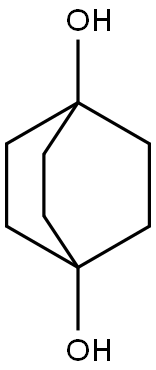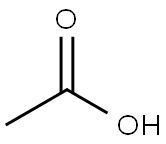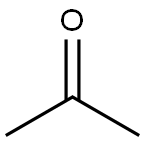
Bicyclo[2.2.2]octane-1,4-diol synthesis
- Product Name:Bicyclo[2.2.2]octane-1,4-diol
- CAS Number:1194-44-1
- Molecular formula:C8H14O2
- Molecular Weight:142.2

4982-20-1
7 suppliers
inquiry
![Bicyclo[2.2.2]octane-1,4-diol](/CAS/GIF/1194-44-1.gif)
1194-44-1
21 suppliers
inquiry
Yield: 85.5%
Reaction Conditions:
Stage #1:1,4-dimethylidenecyclohexane with [bis(acetoxy)iodo]benzene;palladium diacetate;acetic acid in dimethyl sulfoxide at 20;
Stage #2: with sulfuric acid in butan-1-ol at 80; for 3 h;
Steps:
2
The concentrated reaction mixture from Example 1 (It contains 1 ,4- diacetoxybicyclo[2.2.2]octane, 4-acetoxybicyclo[2.2.2]octan-1 -ol and iodobenzene.) was mixed with 10 imL n-butanol or methanol and one drop of sufuric acid in a 100 imL round bottom flask. The mixture was stirred at 80 °C for 3h (with n-butanol) or 60 °C for 6h (with methanol). After the reaction mixture was cooled to room temperature, all liquids were removed under vacumn. Diethyl ether (10 imL) was added to the brown sticky residue and the resulting off-white precipitates were collected through filtration, washed with 5 imL x 3 diethyl ether, and dried in air (1 .12g, 85.5%). GC-MS analysis shows there is only one compound, namely bicyclo[2.2.2]octane-1 ,4-diol, in the precipitates. Its 1H NMR spectra in DMSO-afe features a sharp singlet at δ 1 .58 ppm and a broad singlet at δ 3.93 ppm, consistent with the literature report. {Coll. Czech. Chem. Commun. 1981 , 46, 1370-1375). The crystals of bicyclo[2.2.2]octane-1 ,4-diol suitable for X-ray crystallography were obtained by slowly evaporating the methanol from the corresponding alcoholysis mixture. The crystal structure of bicyclo[2.2.2]octane-1 ,4-diol is shown in Figure 2. (0124) [0048] The structure in Figure 2 was solved and refined using the Bruker SHELXTL Software Package, using the space group 141 cd, with Z = 16 for the formula unit, CsH O2. The final anisotropic full-matrix least-squares refinement on F2 with 99 variables converged at R1 = 3.51 %, for the observed data and wR2 = 9.81 % for all data. The goodness-of-fit was 1 .066. The largest peak in the final difference electron density synthesis was 0.259 eVA3 and the largest hole was -0.163 e /A3 with an RMS deviation of 0.037 elk3. On the basis of the final model, the calculated density was 1 .153 g/cm3 and F(000), 1248 Θ".
References:
EASTMAN CHEMICAL COMPANY;HU, Yue, Rachel;HEMBRE, Robert, Thomas;TUSTIN, Gerald, Charles;BURK, Christopher, Harlan WO2018/75301, 2018, A1 Location in patent:Paragraph 0047-0048

4982-20-1
7 suppliers
inquiry

64-19-7
1599 suppliers
$10.00/25ML
![Bicyclo[2.2.2]octane-1,4-diol](/CAS/GIF/1194-44-1.gif)
1194-44-1
21 suppliers
inquiry
![Bicyclo[2.2.2]octane-1,4-diol 1-acetate](/CAS/GIF/54774-94-6.gif)
54774-94-6
0 suppliers
inquiry
![Bicyclo[2.2.2]octane-1,4-diol diacetate](/CAS/GIF/10364-35-9.gif)
10364-35-9
0 suppliers
inquiry

4982-20-1
7 suppliers
inquiry

141-78-6
665 suppliers
$20.50/250ml
![Bicyclo[2.2.2]octane-1,4-diol](/CAS/GIF/1194-44-1.gif)
1194-44-1
21 suppliers
inquiry
![Bicyclo[2.2.2]octane-1,4-diol 1-acetate](/CAS/GIF/54774-94-6.gif)
54774-94-6
0 suppliers
inquiry

4982-20-1
7 suppliers
inquiry

67-64-1
0 suppliers
$17.30/10ml
![Bicyclo[2.2.2]octane-1,4-diol](/CAS/GIF/1194-44-1.gif)
1194-44-1
21 suppliers
inquiry
![Bicyclo[2.2.2]octane-1,4-diol 1-acetate](/CAS/GIF/54774-94-6.gif)
54774-94-6
0 suppliers
inquiry

4982-20-1
7 suppliers
inquiry
![Bicyclo[2.2.2]octane-1,4-diol](/CAS/GIF/1194-44-1.gif)
1194-44-1
21 suppliers
inquiry
![Bicyclo[2.2.2]octane-1,4-diol 1-acetate](/CAS/GIF/54774-94-6.gif)
54774-94-6
0 suppliers
inquiry
![Bicyclo[2.2.2]octane-1,4-diol diacetate](/CAS/GIF/10364-35-9.gif)
10364-35-9
0 suppliers
inquiry